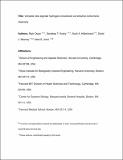| dc.contributor.author | Desai, Rajiv | |
| dc.contributor.author | Koshy, Sandeep Tharian | |
| dc.contributor.author | Hilderbrand, Scott A. | |
| dc.contributor.author | Mooney, David J. | |
| dc.contributor.author | Joshi, Neel S. | |
| dc.date.accessioned | 2015-04-20T19:18:01Z | |
| dc.date.issued | 2015 | |
| dc.identifier | Quick submit: 2015-04-09T15:09:56-04:00 | |
| dc.identifier.citation | Desai, Rajiv M., Sandeep T. Koshy, Scott A. Hilderbrand, David J. Mooney, and Neel S. Joshi. 2015. “Versatile Click Alginate Hydrogels Crosslinked via Tetrazine–norbornene Chemistry.” Biomaterials 50 (May): 30–37. doi:10.1016/j.biomaterials.2015.01.048. | en_US |
| dc.identifier.issn | 0142-9612 | en_US |
| dc.identifier.uri | http://nrs.harvard.edu/urn-3:HUL.InstRepos:14531727 | |
| dc.description.abstract | Alginate hydrogels are well-characterized, biologically inert materials that are used in many biomedical applications for the delivery of drugs, proteins, and cells. Unfortunately, canonical covalently crosslinked alginate hydrogels are formed using chemical strategies that can be biologically harmful due to their lack of chemoselectivity. In this work we introduce tetrazine and norbornene groups to alginate polymer chains and subsequently form covalently crosslinked click alginate hydrogels capable of encapsulating cells without damaging them. The rapid, bioorthogonal, and specific click reaction is irreversible and allows for easy incorporation of cells with high post-encapsulation viability. The swelling and mechanical properties of the click alginate hydrogel can be tuned via the total polymer concentration and the stoichiometric ratio of the complementary click functional groups. The click alginate hydrogel can be modified after gelation to display cell adhesion peptides for 2D cell culture using thiol-ene chemistry. Furthermore, click alginate hydrogels are minimally inflammatory, maintain structural integrity over several months, and reject cell infiltration when injected subcutaneously in mice. Click alginate hydrogels combine the numerous benefits of alginate hydrogels with powerful bioorthogonal click chemistry for use in tissue engineering applications involving the stable encapsulation or delivery of cells or bioactive molecules. | en_US |
| dc.description.sponsorship | Engineering and Applied Sciences | en_US |
| dc.language.iso | en_US | en_US |
| dc.publisher | Elsevier BV | en_US |
| dc.relation.isversionof | doi:10.1016/j.biomaterials.2015.01.048 | en_US |
| dash.license | OAP | |
| dc.subject | Alginate | en_US |
| dc.subject | Hydrogel | en_US |
| dc.subject | Click chemistry | en_US |
| dc.subject | Cell adhesion | en_US |
| dc.subject | Cell encapsulation | en_US |
| dc.subject | Tissue engineering | en_US |
| dc.title | Versatile click alginate hydrogels crosslinked via tetrazine–norbornene chemistry | en_US |
| dc.type | Journal Article | en_US |
| dc.date.updated | 2015-04-09T19:09:56Z | |
| dc.description.version | Accepted Manuscript | en_US |
| dc.rights.holder | Rajiv Desai, Sandeep T. Koshy, Scott A. Hilderbrand, David J. Mooney, Neel S. Joshi | |
| dc.relation.journal | Biomaterials | en_US |
| dash.depositing.author | Joshi, Neel S. | |
| dc.date.available | 2015-04-20T19:18:01Z | |
| dc.identifier.doi | 10.1016/j.biomaterials.2015.01.048 | * |
| dash.contributor.affiliated | Desai, Rajiv M. | |
| dash.contributor.affiliated | Hilderbrand, Scott A. | |
| dash.contributor.affiliated | Koshy, Sandeep | |
| dash.contributor.affiliated | Joshi, Neel | |
| dash.contributor.affiliated | Mooney, David | |


